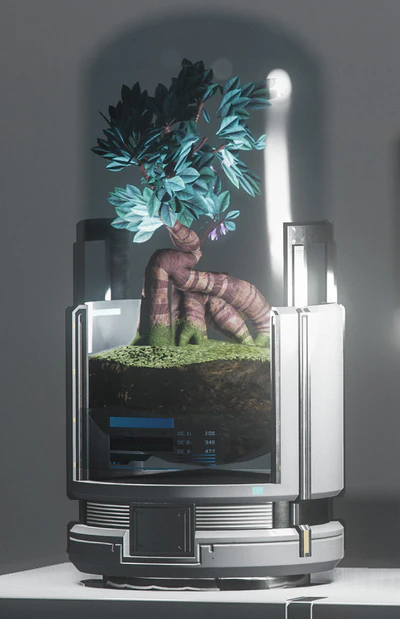 |
||
| Centennial Bloom | ||
|---|---|---|
| Kingdom | Plant | |
| Sentient? | No | |
| Habitat | Eealus III | |
| Status | Prosperous | |
| Diet | Photosynthesis | |
The centennial bloom (Xi'an:pui’arai.ly’ii) is a plant indigenous to Ko’li (Ē’aluth III) that flowers once every 100 Standard Xi’an Years (SXY). Many centennial blooms are tended on R.aip’uāng (Kai’pua II), the center of Li’tova in the Xi’an Empire. Like the centennial bloom’s reproduction cycle, R.aip’uāng’s rotation period completes once every 100 years.[1]
Description and Lifecycle
Standing half a meter tall at its highest, the centennial bloom is a small tree that varies in coloration depending on its particular cultivar. The most common variety has a sturdy, woody trunk with dark-brown and light-brown horizontal banding and dark-green elliptic leaves. Its light-pink flowers are bilaterally symmetrical and have stamens about twice as long as the flower itself. During the short time it blooms, it gives off an earthy scent. Flies and other carrion-eating bugs are its main pollinators on its world of origin, Ko’li. The flower blooms for around 40 hours before it starts to wither, putting all its energy into reproduction. The centennial bloom grows a small, dark-purple berry that’s eaten by local wildlife and propagated in the surrounding areas. Its native desert climate dries out the seeds in preparation for the rainy season. It takes a seed one full Xi’an year to sprout. During that year, it must only be watered sporadically and must never be allowed to remain wet for more than 20 hours or the seed is in danger of rotting. Centennial blooms on R.aip’uāng grown in more temperate areas are kept dry through constant, careful attention and specialized equipment that mimics the day/night cycle on Ko’li. Lovers of the centennial bloom often keep theirs in a sealed arcology that automatically regulates the environment to suit the plant’s needs. Over the past decade, it has increased in popularity as a shipboard plant
Importance to Li'tova
Li’tova is a spiritual practice centered around the understanding of time. One of the main facets scholars contemplate is the way actions ripple backwards and forwards across time. Acknowledging the seen and unseen ramifications of one’s deeds is one of the core principles in the Li’tova code of ethics. Other aspects include the exploration of time as a dimension, the perception of time on an individual level through metabolic manipulation under meditation, and the measurement of time on a collective level. The centennial bloom’s 100-year flowering cycle appeared to the explorers who discovered it on Ko’li to be a poetic manifestation of Li’tova itself. The plant was extracted from Ko’li en masse before its terraforming and exported to R.aip’uāng to be raised and contemplated.
End of the Cold War
At the end of the Xi’an-Human Cold War in 2793, Emperor Kr.ē invited the new Imperator, Erin Toi, for a tour of R.aip’uāng. Though the existence of the jump point was public knowledge, Humans had long been barred from entering the Ē’aluth system. The Emperor personally clipped a branch from a centennial bloom and handed it to Toi. The offer of the centennial bloom and the subsequent opening of the system to all Humans were gestures of peace, made in the hope that the previous age of strife and misunderstanding between the United Empire of Earth and the Xi’an Empire would be replaced with one of cultural exchange and harmony.
References
- ↑ Centennial Bloom (Pui’arai.ly’ii). Galactapedia. Retrieved 2021-02-24